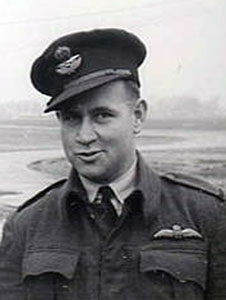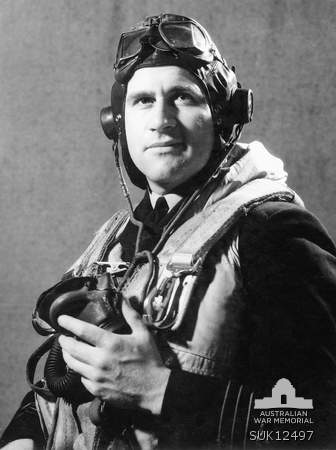On the night of 5th / 6th August 1942 the crew of this 460 Squadron aircraft were tasked with a mine laying flight and left Breighton at 22.18hrs, they "planted their vegetables" successfully and made for home where a landing was made at 06.10hrs but a flak hole was found in the bomb doors.
Pilot - Acting F/Lt William Lloyd Brill RAAF (402933), of Grong Grong, New South Wales, Australia.
? - "Sgt N C Lofts" RAF.
Navigator - P/O Walter Hugh Thompson DFC RAFVR (104578).
? - Sgt L Wilkinson RAF.
Rear Gunner - F/Sgt Kevin William Light RAAF (402447), of Randwick, Sydney, New South Wales, Australia.
Wellington Z1323 was built to contract B97887/40 by Vickers Armstrong's Ltd. at Hawarden, Chester and was awaiting collection in October 1941. It was received by 33 MU on 15th October 1941 and was taken on charge by 460 Squadron on 27th December 1941 at Molesworth. It then moved to Breighton with 460 Squadron on 4th January 1942. As a result of the flak damage on 26th March 1942, on 6th August 1942 and on 28th August 1942 it sustained minor Cat.A/FB damage all times and was repaired on site all times. On 7th September 1942 it was being flown on an operational flight to bomb Duisburg when it was damaged by a night fighter, on the return to the UK it was force landed at Ford and was further damaged. It was initially declared Cat.B/FB but later re-assessed to Re-Cat.Ac on 13th September 1942, then re-assessed again on 15th October 1942 to Re-Cat.B and was taken to the Vickers factory at Weybridge for repair. The aircraft was flown to 48 MU on 5th February 1943 and then to 23 MU on 20th September 1943 but was held in store there. It was later struck off charge on 1st November 1944.

William Brill (pictured above) and Arthur Doubleday were two of the early 460 Squadron pilots, they would become two of the great pilots and leaders of the RAAF and became known as 'The Heavenly Twins'. Brill was best man at Doubleday's wedding. William Brill was born in 17th May 1916 in Ganmain, New South Wales and enlisted on 11th November 1940. He received a commission on 28th July 1941 and received the following promotions during his Wartime career; to F/O on 28th January 1942. Acting F/Lt on 26th July 1942, Acting S/Ldr on 17th April 1943. F/Lt on 27th October 1943 and later rising to Acting W/Co. He was posted to 460 Squadron in January 1942 just after its formation. For his actions on 29th/30th May 1942 he was awarded the DFC, the first awarded to a 460 Squadron airman. He was the pilot of Wellington Z1328 tasked with Ops to Gennevilliers. Having left Breighton at 23.45hrs they were about to bomb the target area when the aircraft was hit by flak. The crew went around and made a second successful bombing run and released all but one of their bombs. One 1,000lb bomb had hung-up in the bomb bay because the bomb release unit had been damaged by flak. The aircraft has been seriously damaged in other areas and on their return to the UK they landed at White Waltham airfield at 05.45hrs. The citation for his DFC was published in the London Gazette on 26th June 1942 and presented at Buckingham Palace on 17th November 1942, the citation reads.."One night in May 1942, this officer was captain of an aircraft, detailed to attack the Gnome Rhone works at Gennevilliers. Bad weather was encountered throughout the journey and fine determination was shown in flying through heavy rain squalls. P/O Brill's aircraft was caught in searchlights, and anti-aircraft fire damaged the hydraulic system and put the rear turret out of action. After making a circuit at 1,500 feet P/O Brill carried out an attack at 2,000 feet, and hit the target. The hydraulic pipes, operating the bomb doors, were subsequently damaged and the bomb doors could not be closed. The return journey was made in bad waather. P/O Brill, thinking that he would probably have to make a crash landing, decided to descend away from his base, and he succeeded in making a good landing without flaps and with one wheel damaged. This officer showed splendid courage and determination and has proved to be a resourceful pilot at all times."

He was posted to 463 Squadron in late-1942 and while serving with them he was awarded the DSO, published in the London Gazette on 19th May 1944 while an Acting S/Ldr and presented at Buckingham Palace on 10th October 1944. The citation reads.. "This officer has completed a very large number of sorties and throughout has displayed leadership, skill and gallantry of the highest order, whilst his determination to make every sortie a success has been notable. On one occasion, whilst over Berlin, his aircraft sustained damage when fires started in one of the wings and in the fuselage. Although the rudder controls were affected and the compass was unserviceable, Squadron Leader Brill flew the damaged aircraft to base. On another occasion, more recently, his aircraft was hit by shrapnel whilst over the target. One engine was put out of action, some navigational equipment was rendered useless and other damage was sustained. In spite of this and in the face of adverse weather, Squadron Leader Brill flew the aircraft safely home. His record is worthy of the highest praise." He later commanded 467 Squadron from 12th May 1944 to 12th October 1944 and awarded the Bar to the DFC for service with 467 Squadron as Acting W/Co, Gazetted on 16th January 1945 though no citation for this has been located. He returned to Australia in January 1945 and remained in the RAAF rising to the rank of Group Captain. He died on 12th October 1964.
Walter Thompson appears to have been known by his second name "Hugh". He was awarded the DFC for service with 460 Squadron, Gazetted on 11th August 1942. The citation reads.. "This officer has displayed a high degree skill and initiative throughout his operational career. His skilful navigation has contributed in a large way to the successful conclusion of the numerous sorties in which he has participated. One night in May, 1942, he was navigator of an aircraft which was severely damaged by enemy fire. His co-operation, coolness and devotion to duty were of great assistance to his captain in difficult circumstances." Prior to enlisting he was a scientist and took an early interest in the developments of Oboe, H2S and other navigation aids. On 23rd August 1941 he was granted a commission to the rank of P/O on probation (emergency), on 23rd August 1942 he rose to F/O (war subs) and exactly a year later he rose to he rose to F/Lt (war subs). having survived the War he was Mentioned in Despatches on 1st January 1946. He remained in the RAF until 1954, when on 21st April 1954 he reliquished his commission of S/Ldr but retaining the rank of F/Lt.
The 460 Squadron record book gives the name "Sgt N C Lofts" as being the identity of the airmen in this aircraft and in subsequent flights with Bill Brill, however nothing more is known of him. A Sgt Frederick G Lofts RAF (1257974) was awarded the DFM for service with 460 Squadron and may be his true identity, if so the citation for his DFM reads.. "As wireless operator/air-gunner this airman has participated in numerous sorties, and his excellent work has contributed materially to the successes achieved."
Kevin Light was born on 29th January 1921 in Sydney and enlisted on 19th August 1940 in Sydney, he was working as a welder at the time. After initial training in Canada and time with 21 OTU in the UK from 14th June 1941 Sgt Light was posted to 142 Squadron on 16th August 1941 and was the only survivor of Wellington Z1243's crash at Grimsby on 25th November 1941. Recovering from his serious injuries he was posted to 460 Squadron on 25th February 1942; this was common for early 460 Squadron to come from 142 Squadron. He was awarded the DFM for service with 460 Squadron in completing his Tour, Gazetted on 19th December 1942, the citation reads.. "As wireless operator / air gunner this airman has participated in attacks on targets both in Germany and in German occupied territory. He has at all times displayed commendable courage and devotion to duty, whilst his high skill has made him a valuable member of aircraft crew." He was posted to 27 OTU on 19th April 1943 probably to instruct and received his commission to the rank of P/O on 12th June 1943 (and later to F/O on 11th December 1943 and F/Lt on 11th June 1945). His next postings were 1661 HCU on 21st August 1943 and 1654 HCU on 9th November 1943. He later began a second Tour with 9 Squadron begining 15th January 1944 but was made a PoW on 18th April 1944 on Ops to Juvisy, France in Lancaster LM361 when the aircraft was shot down by anti-aircraft guns and crashed on a railway line at Lonjumeau. Four of the crew died but three survived after baling out and evaded capture until he was captured by the Gestapo in Paris on 7th July 1944. The others evaded capture. He was initially held in a prison in Paris until being transferred to Buchenwald Concentration Camp on 8th September 1944 and later going to Stalag Luft III on 12th November 1944 until 2nd May 1945. He returned home and received his discharge.